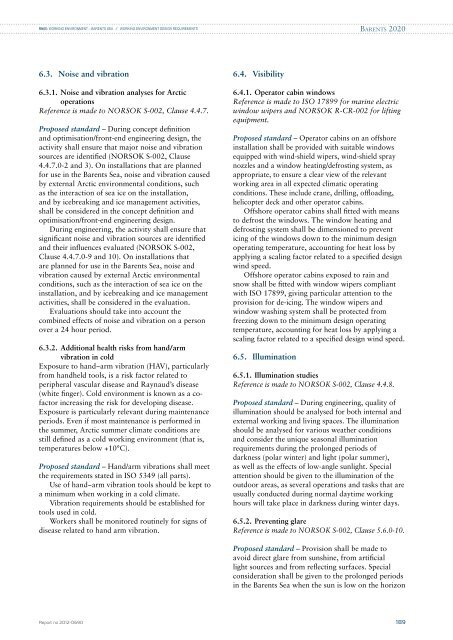phase 4 report - DNV
phase 4 report - DNV
phase 4 report - DNV
You also want an ePaper? Increase the reach of your titles
YUMPU automatically turns print PDFs into web optimized ePapers that Google loves.
RN05: WORKING ENVIRONMENT – BARENTS SEA // Working environment design requirementsBarents 20206.3. Noise and vibration6.3.1. Noise and vibration analyses for ArcticoperationsReference is made to NORSOK S-002, Clause 4.4.7.Proposed standard – During concept definitionand optimisation/front-end engineering design, theactivity shall ensure that major noise and vibrationsources are identified (NORSOK S-002, Clause4.4.7.0-2 and 3). On installations that are plannedfor use in the Barents Sea, noise and vibration causedby external Arctic environmental conditions, suchas the interaction of sea ice on the installation,and by icebreaking and ice management activities,shall be considered in the concept definition andoptimisation/front-end engineering design.During engineering, the activity shall ensure thatsignificant noise and vibration sources are identifiedand their influences evaluated (NORSOK S-002,Clause 4.4.7.0-9 and 10). On installations thatare planned for use in the Barents Sea, noise andvibration caused by external Arctic environmentalconditions, such as the interaction of sea ice on theinstallation, and by icebreaking and ice managementactivities, shall be considered in the evaluation.Evaluations should take into account thecombined effects of noise and vibration on a personover a 24 hour period.6.3.2. Additional health risks from hand/armvibration in coldExposure to hand-arm vibration (HAV), particularlyfrom handheld tools, is a risk factor related toperipheral vascular disease and Raynaud’s disease(white finger). Cold environment is known as a cofactorincreasing the risk for developing disease.Exposure is particularly relevant during maintenanceperiods. Even if most maintenance is performed inthe summer, Arctic summer climate conditions arestill defined as a cold working environment (that is,temperatures below +10°C).Proposed standard – Hand/arm vibrations shall meetthe requirements stated in ISO 5349 (all parts).Use of hand-arm vibration tools should be kept toa minimum when working in a cold climate.Vibration requirements should be established fortools used in cold.Workers shall be monitored routinely for signs ofdisease related to hand arm vibration.6.4. Visibility6.4.1. Operator cabin windowsReference is made to ISO 17899 for marine electricwindow wipers and NORSOK R-CR-002 for liftingequipment.Proposed standard – Operator cabins on an offshoreinstallation shall be provided with suitable windowsequipped with wind-shield wipers, wind-shield spraynozzles and a window heating/defrosting system, asappropriate, to ensure a clear view of the relevantworking area in all expected climatic operatingconditions. These include crane, drilling, offloading,helicopter deck and other operator cabins.Offshore operator cabins shall fitted with meansto defrost the windows. The window heating anddefrosting system shall be dimensioned to preventicing of the windows down to the minimum designoperating temperature, accounting for heat loss byapplying a scaling factor related to a specified designwind speed.Offshore operator cabins exposed to rain andsnow shall be fitted with window wipers compliantwith ISO 17899, giving particular attention to theprovision for de-icing. The window wipers andwindow washing system shall be protected fromfreezing down to the minimum design operatingtemperature, accounting for heat loss by applying ascaling factor related to a specified design wind speed.6.5. Illumination6.5.1. Illumination studiesReference is made to NORSOK S-002, Clause 4.4.8.Proposed standard – During engineering, quality ofillumination should be analysed for both internal andexternal working and living spaces. The illuminationshould be analysed for various weather conditionsand consider the unique seasonal illuminationrequirements during the prolonged periods ofdarkness (polar winter) and light (polar summer),as well as the effects of low-angle sunlight. Specialattention should be given to the illumination of theoutdoor areas, as several operations and tasks that areusually conducted during normal daytime workinghours will take place in darkness during winter days.6.5.2. Preventing glareReference is made to NORSOK S-002, Clause 5.6.0-10.Proposed standard – Provision shall be made toavoid direct glare from sunshine, from artificiallight sources and from reflecting surfaces. Specialconsideration shall be given to the prolonged periodsin the Barents Sea when the sun is low on the horizonReport no 2012-0690 189






![Risk Based Pipeline Integrity Management [Compatibility Mode] - DNV](https://img.yumpu.com/50424229/1/190x146/risk-based-pipeline-integrity-management-compatibility-mode-dnv.jpg?quality=85)









